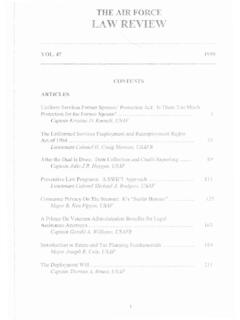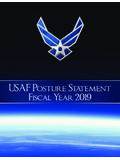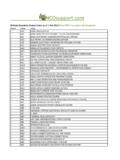Transcription of AIR FORCE OPERATIONS AN TE LA - afjag.af.mil
1 AIR FORCEOPERATIONSANDTHEAWLTHE JUDGE ADVOCATE GENERAL S SCHOOLUNITED STATES AIR FORCER eaders with questions or comments concerning this publication should contacts the Editors, Air FORCE OPERATIONS and the Law, at the following address:The Judge Advocate General s School150 Chennault Circle (Bldg 694)Maxwell Air FORCE Base, Alabama 36112-6418 Comm.(334) 953-2802 or DSN publication is available at: the cover: pre-flight checks on a F-15E Strike Eagle ( Air FORCE photo/Airman First Class Joshua Kleinholz).iThird Edition 2014 Air FORCE OPERATIONS And the LAwPUBLICATION LAYOUT and COVER DESIGNMS. THOMASA T. PAULCOLONEL KIRK L. DAVIES, usaf Commandant, the Judge advoCate general s sChoolLIEUTENANT COLONEL ERIC M. JOHNSONMAJOR LAURA C. DESIOMAJOR SAM C. KIDDMS. THOMASA T. PAULP rofessional outreaCh divisionAir FORCE OPERATIONS and the Law is a publication of the Judge Advocate General s School. This book is a reference tool for legal professionals who support military OPERATIONS and should be viewed as a secondary authority.
2 As with any publication of secondary authority, this guide should not be used as the basis for action on specific cases. Primary authority, much of which is cited in this edition, should be carefully reviewed. iiFOREWORDT hroughout our nation s history, the military has adapted to overcome national threats. We have done so, generation by generation, often armed with legal principles, many of which did not neatly fit our adversaries emerging means and methods of warfare. Technological advances in the 21st Century involving, for example, cyber forces, space assets, lasers, distributed OPERATIONS , and remotely piloted aircraft will continue to push us into unchartered legal territory. The success of commanders in this complex strategic environment largely depends on responsive legal advice that applies all relevant law to novel circumstances under increasingly compressed decision cycles. Quality legal advice presupposes engaged JAG Corps personnel who are well versed in their unit s missions and can articulate, in operationally informed language, how the law applies to those specific Air FORCE defines OPERATIONS Law expansively: The domestic, foreign, and in-ternational law associated with the planning and execution of military OPERATIONS in peacetime or hostilities.
3 The application of law to a specific mission of the supported Air FORCE unit. AFI 51-108, Judge Advocate General Corps Structure, Deployment, and Operational Support. Note the powerful implication. Because all usaf missions involve support for military OPERATIONS in some way, this definition means that whatever law ap-plies to your commander s mission is OPERATIONS law. Do you have range control issues? Does your wing write contracts that support an operational mission? Does your com-mander face good order and discipline challenges? These all impact your commander s missions. Put otherwise: OPERATIONS law entails a general practice encompassing all law and regulation that influences the organizing, training, equipping, or employment of armed FORCE . Expansive robust concept of OPERATIONS law presupposes that every judge advocate and paralegal fully comprehends his or her unit s mission. Do you? Can you explain your unit s mission? Are you conversant with the mission of the tenant units your legal office supports?
4 Can you connect the dots to explain how your unit s mission supports the usaf core missions of (1) air and space superiority; (2) intelligence, surveillance and reconnaissance; (3) rapid global mobility; (4) global strike; and (5) command and control? (From Global Reach, Global Vigilance, Global Power for America, 2013).iiiStaff judge advocates must effectively tailor their legal practices and training programs to best suit the supported unit s mission. This third edition is a tool to help you do just that, as the entire JAG Corps practices OPERATIONS law every day. This publication does not and could not cover every subset of OPERATIONS law. However, it will help get you started in addressing those challenging legal practice issues not readily covered elsewhere. And, it will enable you to deliver essential legal services in support of usaf old adage found on plaques and bookmarks, good lawyers know the law, great lawyers know the judge, can be modified for our purposes to read, good JAGs know the law, great JAGs know the mission.
5 You, of course, must know both and be prepared to apply that law to the mission to assist commanders across the entire spectrum of Air FORCE OPERATIONS . The mission s success depends on it, and the Airmen we serve depend on us to deliver the professional, candid, independent, and quality legal counsel that overcomes the threats and secures victory. CHRISTOPHER F. BURNE Lieutenant General, usaf The Judge Advocate GeneralivCHAPTER ONE: INTERNATIONAl UsE OF FORCE by THE UNITED sTATEs AIR FORCE ..1 Background ..2 Law Governing When Nations Can Legally Use FORCE ..2UN Enforcement Actions ..3 Self-Defense ..4 Use of FORCE with Consent of the Territorial State ..6 Domestic Law and the Use of FORCE : The War Powers Resolution ..6 CHAPTER TWO: lAW OF ARmED CONFlICT (lOAC) ..9 Background ..10 United States View of The Law of Armed Conflict Generally ..10 Sources of The Law of Armed Conflict for Airmen ..11 Basic Principles of The Law of Armed Conflict ..13 The Laws of Aerial Warfare.
6 20 CHAPTER THREE: WAR CRImEs AND ENFORCEmENT OF l OAC .. and Classification of War Treaty Department of Defense Policy ..40 Methods of Enforcement ..43 Reprisals ..44 AIR FORCE OPERATIONS AND THE lAW Table of ConTenTsvProsecution of War Crimes Under Law ..44 Prosecution of War Crimes Under International Law ..47 Criminal Responsibility ..51 Defenses ..55 Non-International Armed Conflict ..59 Peacetime OPERATIONS ..62 CHAPTER FOUR: AIR AND sEA lAW ..65 Background ..66 Airspace and Air Navigation ..67 Aircraft ..69 Air Navigation ..72 Special Navigation Issues ..77 Self-Defense and Armed Conflict ..79 CHAPTER FIVE: sPACE lAW ..83 Introduction What Space Brings to the Legal and Policy Framework ..85 Major Space Principles and Their Implications for Military Space Activities ..89 Other Operational Considerations ..97 Conclusion ..98 CHAPTER sIX: CybER OPERATIONS lAW ..103 Background ..104 Application of the Law of Armed Conflict (LOAC) ..105viLegal Reviews of Cyber Capability.
7 108 Cyber Targeting Issues .. Cyber Policy ..109 Examples of Cyber OPERATIONS ..110 Other Cyberspace Issues ..111 Electronic Warfare (EW) ..113 CHAPTER sEVEN: INTERNATIONAl AgREEmENTs ..115 What Constitutes an International Agreement ..116 Authority for Executive Agreements ..116 Procedural Authority ..117 Substantive Legal Authority ..125 CHAPTER EIgHT: sTATUs OF FORCEs AgREEmENTs ..149 Background ..151 Purpose of Sofas ..152 Geographical Application ..152 Types of Status Arrangements ..153 Content of Sofas ..154 Common ..160 CHAPTER NINE: FOREIgN CRImINAl JURIsDICTION ..163 Background .. Policy Concerning Foreign Criminal Jurisdiction ..165viiRole of the Designated Commanding Officer (DCO) and Country Representative ..166 Source and Types of Jurisdictional Arrangements ..167 The NATO SOFA ..168 Jurisdiction over Civilians and Dependents .. State Exercise of Jurisdiction Procedural Protections ..172 Military Administrative Actions ..174 Reports Required.
8 175 Jurisdiction of Service Courts of Friendly Foreign Forces in the United States ..177 CHAPTER TEN: ACqUIsITION AND CROss-sERVICINg AgREEmENTs ..185 Background ..186 Types of ACSAs ..186 Limitation on Use of ACSAs ..187 ACSA Process ..188 Specific Transactions under ACSAs ..189 Judge Advocate Responsibilities ..190 CHAPTER ElEVEN: INTERNATIONAl ORgANIzATIONs ..193 Background ..195 Theory of Governmental International Organizations ..196 Legal Issues of Governmental International Organizations ..197 Key International Organizations ..198 The United Nations (UN) ..198 North Atlantic Treaty Organization (NATO) ..205viiiOrganization of American States (OAS) ..206 Organization for Security and Cooperation in Europe (OSCE) ..206 Council of Europe and the European Court of Human Rights ..207 European Union (EU) ..207 Association of Southeast Asian Nations (ASEAN) ..209 International Committee of the Red Cross (ICRC) ..209 CHAPTER TWElVE: HUmAN RIgHTs lAW ..213 Background.
9 214 Application of Human Rights Law to OPERATIONS ..214 Content of Human Rights Law ..215 usaf Obligations to Prevent or Punish Human Rights Violations During OPERATIONS ..218 Considerations When Working in a Coalition ..218 CHAPTER THIRTEEN: THE OPERATIONAl CHAIN OF COmmAND sUCCEssION ..221 Background ..223 Constitutional and Statutory Authority ..223 The Concept of Command by Uniformed Military Personnel ..224 Types of Command Authority ..227 Derivation of Authority for the Joint FORCE Air Component Commander ..232 JFACC COMAFFOR Relationship ..233 Command Discipline and Personnel Administration ..234 Command Succession ..237 Special Rules and Limitations to Command (AFI 51-604) ..238 North Atlantic Treaty Organization (NATO) and Coalition Air OPERATIONS ..241ixCHAPTER FOURTEEN: INTEllIgENCE ACTIVITIEs ..245 Background ..246 Building a Basic Understanding of Air FORCE Intelligence Organizations and Responsibilities ..246 Four Step Process for Issue Spotting Intelligence Activities.
10 247 Reporting Questionable Intelligence Activities or Those Involving Highly Sensitive Matters ..251 CHAPTER FIFTEEN: RUlEs OF ENgAgEmENT ..253 Background ..255 Purposes of ROE ..255 Sources of ROE ..256 Source Documents for the Development of ROE ..258 The Standing Rules of Engagement/Standing Rules for the Use of FORCE ..258 General Principles Contained in the SROE ..260 Multinational Considerations ..262 Functional Enclosures ..263 Fundamentals of ROE Planning in Air OPERATIONS ..264 ROE Control, Dissemination and Training ..264 CHAPTER sIXTEEN: TARgETINg AND ..269 Targeting and Legal Considerations ..269 Principles of Aerial Targeting ..270 Rules of Engagement ..274x ROE-Like Restrictions Impacting Targeting ..274 Targeting and Weaponeering ..275 The Deliberate Targeting Process ..278 The Dynamic Targeting Process ..282 CHAPTER sEVENTEEN: JOINT OPERATIONS PlANNINg ..287 Background ..288 Overview of Joint Operation Planning ..288 Planning ..291 The Planning Process.






